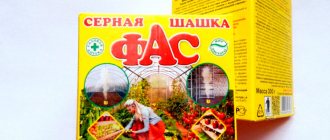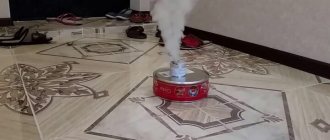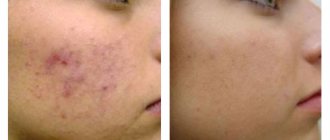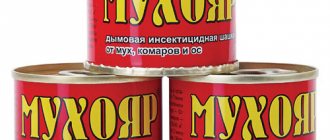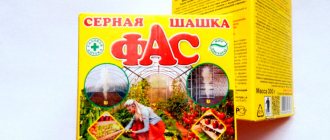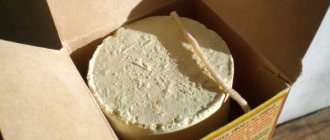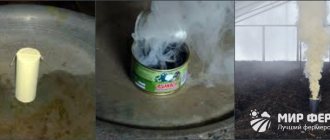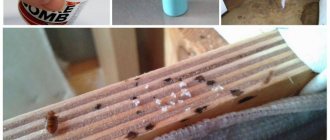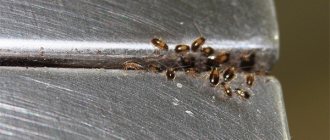Purpose of smoke bombs
Sulfur and tobacco bombs are intended for disinfection of greenhouses, greenhouses, greenhouses, cellars and vegetable stores. They are today the most popular means of fumigation for these purposes.
SULFUR block is a product intended for the destruction of bacterial infections, mold, fungi, insect pests in EMPTY vegetable stores, greenhouses and conservatories, as well as in cellars and basements outside residential premises. The fumigant in this case is sulfur dioxide - a gas formed during the smoldering of a sulfur bomb.
Examples of trademarks of SULFUR bombs
Unlike the sulfur block, which is used only for empty greenhouses and vegetable storages, the tobacco block allows processing in greenhouses at all stages of vegetative growth of plants, as well as in vegetable storehouses and cellars with vegetables and fruits already stored in them.
TOBACCO checker is effective in the fight against insect pests, such as: stalk beetles, sawflies, copperheads, leaf rollers, whiteflies, spider mites, thrips, aphids, potato moths, vegetable flies, cabbage moths, tomato moths, root mites and many others. Tobacco smoke promotes the growth and strengthening of plants. The use of tobacco in cellars and vegetable stores slows down the process of decomposition of chlorophyll, organic sugars and acids, starch, thereby extending the shelf life of products.
Examples of TOBACCO brands
How to use a checker to process a greenhouse: rules and stages of work
To carry out disinfection without harming your health, you need to properly prepare the room, protect yourself, and read the instructions for use.
Here are the detailed instructions:
- The soil in the greenhouse must be completely cleaned: remove the tops, weed out the weeds.
- If there are things in the greenhouse that can be easily removed (for example, boxes), it is better to remove them. When processing with a sulfur bomb, it is necessary to remove all metal or wooden products (or at least cover them tightly). Metal surfaces can be covered with a thick layer of grease (then they do not need to be taken out or covered).
- Clean the walls and ceiling thoroughly. If there are fungal infections, you need to clean off all the mold with a stiff brush. The polycarbonate greenhouse can be washed with a washcloth and detergent.
- Burnt products can penetrate dense soil to a shallow depth (up to 5 cm), so it is better to thoroughly loosen the soil. This is necessary to remove mold, insects and their larvae, even if they are in the soil.
- During the burning of the checker, the room must be tightly sealed. It is better to close all the vents, windows and ventilation holes in advance and prepare everything to quickly and tightly close the door. A thick piece of waste fabric or construction tape is suitable for this.
- It is necessary to moisten the space, walls and soil. For what? In a humid environment, the bomb burns longer, and the combustion products act better.
- In the middle of the greenhouse you need to install a platform made of fireproof material (on it there will be a checker, which gets very hot when burning). A ceramic vessel or several bricks can serve as a platform.
- Before using a saber, you need to take care of your own safety: put on a protective suit, rubber gloves, a gas mask or respirator, and remove your hair. In principle, these precautions are not mandatory: if you set fire to only 1 checker and immediately leave the room after setting it on fire, then the person will not receive any harm. But it is still recommended to wear protective equipment just in case.
- To set a checker on fire, you need to place it on a prepared platform in a strictly vertical position.
- You can light the wick using a barbecue lighter, barbecue matches or a folded piece of paper. If the humidity in the room is high and the wick does not light, it can be moistened with kerosene. The use of gasoline and diesel fuel is strictly prohibited.
- After making sure that the flame has become stable, you need to immediately leave the room and close the door tightly behind you, taping or covering all the cracks with tape or cloth. The wick will burn for several tens of seconds (the exact time is usually written on the packaging).
- You need to take off all your clothes and wash them thoroughly, and immediately take a shower.
Combustion occurs within 2-3 hours (may vary slightly depending on the humidity in the room). The active substances released during the combustion process act for 2-3 days.
After 3 days, the greenhouse must be opened and ventilated.
If the greenhouse area is large and requires the use of several blocks, you should not install them all in one place. For greater efficiency and uniform processing, it is better to distribute them over the entire area of the greenhouse.
We said above that tobacco, unlike sulfur, is safe. A reasonable question arises: is it necessary to take the same precautions? Not necessary, but it won't hurt.
Processing a greenhouse with a sulfur bomb (video)
How many checkers are needed: quantity calculation
The instructions for each checker indicate how much space it is designed for. The entire cylinder consists of several tablets, usually 5 or 10. To determine how many tablets you need, calculate the volume of the greenhouse.
For example, we are dealing with a greenhouse 2x4 m and 2 m high. To calculate the volume, you need to multiply all three parameters: 2*4*2=16 m³. One block, consisting of 10 tablets, weighing 300 grams, is designed for 20 m³. For our greenhouse, 8 tablets will be enough to treat it.
How to get rid of mold in the basement of your home: methods of control and preventive measures
Effective ways to combat mold (fungus) in the bathroom
Related Posts
Consumption rate and frequency of treatments
Depending on the composition of the checker, as well as on the nature of the treatments carried out (preventive or therapeutic), the consumption rates and frequency of treatments vary.
When using a sulfur bomb
Important – Treatment of greenhouses, hotbeds and greenhouses with a sulfur bomb is carried out ONLY BEFORE planting crops, or after harvesting
| Type of treatments | Consumption rate* |
| For greenhouses, hotbeds and conservatories | 60g/m3 or 1 checker weighing 300g. at 5m3 |
| For basements and cellars | 30-60g/m3. |
*Treatment with a sulfur bomb is carried out once
Treatment of cellars and vegetable stores with smoke bombs
Important - Empty cellars and basements must be treated with SULFUR pellets ONLY BEFORE STORING vegetables.
Sulfur bomb is available in different brands - Klimat, Vist, Hephaestus, Fomor or FAS. The principle of action, dosage and frequency of treatments are similar for all, there are no fundamental differences.
The following video shows the procedure for using a sulfur bomb when processing a greenhouse.
When using a tobacco stick
| Type of treatments | Consumption rate | Frequency of treatments |
| In greenhouses for the prevention and stimulation of plant growth | 1 checker weighing 230-250g. at 50m3 | up to 5 treatments, with an interval of 5-8 days |
| In greenhouses when insect pests are detected | 1 checker per 25-30m3. | 2-3 times, with an interval of 48 hours |
| Vegetable storage processing | 1 checker per 25-30m3 | up to 3 treatments, with an interval of 48 hours, for prevention - up to 6 treatments, with an interval of 7-10 days |
Important - TOBACCO block can be used for processing greenhouses DURING the ENTIRE growing season of plants, and when processing cellars even if there are vegetables and fruits in them
Currently, the following brands of tobacco sticks are produced and used: “Hephaestus”, “Vulcan”, “Fitophtor”, “Fomor”. There are no significant differences between them; you can use any one.
The following video shows the procedure for using a tobacco stick.
Advantages and disadvantages of sulfur bombs
A greenhouse bomb based on sulfur effectively kills insects, infections, microorganisms, and their smoke also disinfects the surfaces of buildings and soil. Sulfur is not dangerous when used in small doses, even if the checkers are used with subsequent long-term preservation. When used correctly, checkers do not cause harm to health; it is important to use thick clothing, rubber gloves, a respirator, and goggles. However, if inhaled, sulfur is deadly; it is for this reason that it is important to protect yourself from the influence of the checkers by lighting them, starting from the point farthest from the entrance. You should also promptly leave the premises.
Disadvantages of checkers with sulfur:
- negative effect on metal;
- you need to wipe the polycarbonate from moisture, otherwise it will react and darken;
- not suitable for residential premises;
- not permissible in case of connection with residential premises;
- cannot be used in the presence of plants.
Advantages of use:
- a large number of threats can be eliminated with a sulfur bomb in a greenhouse;
- high efficiency;
- perfectly replaces chemicals;
- removes lesions from wooden surfaces and dries.
Fumigation procedure
- Remove the checker and wick from the packaging.
- Place the required number of checkers vertically on stands made of non-flammable material.
- Place the checkers in the room being treated at a distance of at least 0.5 m from flammable objects.
- Close transoms, sashes, windows. Eliminate gaps between frames, doors, cellar lids - seal with damp cloth, felt, foam rubber or other sealing agents.
- For a SULFUR checker - put the wick on the corner of the checker and set it on fire, making sure that the smoldering process begins (a dark spot should form at the point of contact of the hot wick and the sulfur bomb), quickly leave the room, closing the door tightly.
Application of sulfur smoke bomb
- For a TOBACCO stick - without removing the cardboard membranes, light the stick, after ignition, quickly remove your hands, since the combustion process immediately begins with abundant release of smoke without fire.
Use of tobacco smoke bomb
- Fumigation (fumigation with smoke) is carried out within 24-36 hours. The smoke easily penetrates into all corners of the room being treated, thereby ensuring disinfection as effectively as possible.
- After fumigation is completed, the room is ventilated for about 1-2 days until the specific odors completely disappear.
Popular types of checkers from manufacturers
Smoke bombs from various manufacturers can be found on sale on the Russian market in specialized stores. The most popular drugs are:
- Sulfur blocks for greenhouses “Climate” are the most popular. They have a fairly standard design with a wick that is lit. Climate is used for processing vegetable stores and on livestock farms. This type of checker works very well against fleas and lice. Its price is about 70 rubles per package.
- The smoke bomb for the FAS greenhouse is cheaper, but very toxic. After treating the room, long ventilation is required. This drug should not be used in premises where animals will be kept.
- Smoke bombs against insects "ITI" are often used in homestead farming. In this product, instead of sulfur, a substance is added - permethrin. It is considered more effective for killing cockroaches, ants and woodlice. Of all the types of smoke bombs for treating greenhouses, this product is the most expensive, its price reaches 290 rubles.
- For large rooms, it would be ideal to use Vulcan, another type of sulfur smoke bombs. It is capable of handling large warehouses of logistics centers or enterprises. It has an inexpensive price - up to 50 rubles.
- “Peshka-S” is well suited for polycarbonate greenhouses; this product works well against unwanted insects.
Preventive measures and remedies for aphids on cucumbers
Security measures
During production and storage, the checkers correspond to hazard class 4 (low-hazardous compound).
When working with a sulfur bomb, the work carried out is classified as hazard class 2 (dangerous compound) due to its irritating effect on mucous membranes.
Sulfur itself is practically harmless to people and animals, but the secondary product formed during decay - sulfur dioxide - poses a danger to mammals, birds, bees, etc.
Sulfur dioxide, released during smoldering sulfur bombs, is toxic and, if inhaled, can lead to severe poisoning, signs of which are manifested in dizziness, coughing attacks, hoarseness, pain in the eyes, nosebleeds, pain in the chest and epigastric region.
Treatment with checkers is carried out in the absence of people and pets. When planting a checker, use personal protective equipment. Upon completion of work, do not leave unused remains of the sulfur bomb on the soil surface and do not throw it into water bodies.
Safety measures during transportation, use and storage should be taken into account and observed in accordance with SanPiN 1.2.2584-10. According to the instructions, for the safe use of checkers, processing must be carried out by two people. One person is inside the room - places and lights the checker, the second is outside - to control the process.
Sulfur dioxide, which is released when sulfur bombs smolder, is toxic.
Unlike a sulfur bomb, the use of a tobacco bomb does not require the use of special protective measures.
Instructions for use
In order for the room to be processed safely, you must correctly follow the instructions for use of the product.
The estimated consumption of the product is 1 checker per 5-10 “cubes” of space. If the room is large, and several checkers are used to process it, they need to be placed and set on fire in such a sequence that the person moves in the direction of the exit.
Step-by-step instructions for use:
- Remove all items that can be removed from the area being treated. Be sure to remove food (including canned food) and plants.
- We treat metal surfaces with anti-corrosion agents. Sulfur dioxide released during combustion accelerates the corrosion of metals. To avoid this, you need to coat the metal surface with paint or coat it with grease.
- In the room being treated, all cracks and openings should be tightly closed: windows, ventilation ducts, any leaks. You also need to prepare in advance for sealing door cracks - you can use tape for this purpose.
- We place a pedestal on the floor (50-100 cm from flammable objects or substances) on which the checker will stand. For these purposes, you can use several bricks, forming a kind of “foundation”. It should be wide enough - approximately 30x30 cm. If the floor is wooden, you should use a metal basin instead of a brick pedestal.
- We place the checker on the “foundation” and remove the protective film.
- Insert a wick into the checker and light it with matches/lighter.
- Wait for a small amount of smoke to appear and leave the room immediately. The wick burns (smolders) for a little longer than 30 seconds.
- We close the front door and seal all the cracks on the outside.
The combustion process itself takes from half an hour to 80 minutes (depending on the humidity in the room).
You cannot enter the premises for 36-48 hours; this time is just enough for processing. After this period, the room must be ventilated for two days. If this is not enough (the smell of sulfur is felt), we extend the ventilation for another 1-2 days.
Example of greenhouse processing (video)
Safety precautions for use
During the manufacturing process (production) or storage at home, the checker is not dangerous (neither for humans, nor for animals, nor for plants), and belongs to the fourth hazard class (low-hazardous compound).
During the combustion process, the substance released belongs to the second hazard class. Therefore, you need to use personal protective equipment to process the premises:
- Respirator (ideally a gas mask).
- Latex gloves.
- You can use a protective apron or boots - but this is not necessary, as long as you have just a change of clothes (not used anywhere in everyday life).
Please note: gauze bandages, homemade respirators with cotton wool filters - all this will not protect against the combustion of sulfur and the formation of sulfur dioxide. In this case, only professional personal protective equipment has protective functions.
Ideally, the work should be done by two people. Both people can lay out checkers, seal cracks and close holes. After which one leaves the room, and the second sets it on fire. The first one in this case plays the role of a belayer - in case of danger, he helps the one who sets the fire to get out. Therefore, both need to use protective equipment.
Smoldering Checker
After treating the room, wash your clothes thoroughly, change the filters on your respirator or gas mask, and take a shower (be sure to use soap). It is advisable to rinse your mouth (immediately after treatment) and drip a saline solution into your nose (for rinsing).
Call an ambulance immediately if the following symptoms occur (during treatment, when you left the premises, or after it):
- headache and/or dizziness;
- attacks of nausea, vomiting;
- pain in the chest, shortness of breath;
- nose bleed;
- difficulty breathing (inability to inhale or exhale normally), wheezing, cough without relief.
Such symptoms indicate poisoning by combustion products. Delayed medical care can lead to serious consequences and even death.
How to properly use a checker for processing greenhouses: detailed instructions
How to properly use a sulfur bomb Climate: instructions
Related Posts
Features of processing polycarbonate greenhouses
All modern greenhouses are made of polycarbonate on a metal frame. When using a sulfur bomb, corrosion of the metal parts of the greenhouse is possible. To avoid this, you should insulate them - either primed and coated with a special coating, or lubricated with a thick layer of machine oil.
A galvanized profile also requires protection, but an aluminum profile does not require treatment.
The polycarbonate itself does not noticeably deteriorate from the sulfur bomb - it does not become cloudy or crack, unless the dosage is exceeded. Its destruction is facilitated by climatic factors - frost and sun, winds, snow load, etc.
Advantages and disadvantages
The advantages of using smoke bombs include:
- convenience and ease of use
- maximum effect in destroying pathogens of fungal and bacterial plant diseases;
- the ability to disinfect any surfaces from fungus, mold and rot;
- destruction of not only insect pests, but also their larvae;
- safe disposal of rats, house mice, voles using sulfur bombs;
- air drying;
- the opportunity to refuse the use of chemical pesticides.
The disadvantages include:
- the released sulfur dioxide is toxic to humans and animals;
- will not completely destroy fungal or pest spores in the soil;
- oxidizes metal, it is not recommended to use a sulfur bomb for processing greenhouses with untreated metal profiles;
- a smoke bomb is a fire hazard.
Using sulfur bombs in a greenhouse
Only empty rooms where there are no edible mushrooms - oyster mushrooms and champignons, vegetables and fruits - are treated with sulfur.
The room is emptied, leaving drawers, boxes, empty shelves - everything that needs to be disinfected, and only then is cleaning carried out.
It is also worth taking out metal products to avoid oxidation. If the frame of the greenhouse is made of metal, it should be pre -lubricated with grease or painted .
As already mentioned, sulfur smoke reacts with moisture and forms sulfuric acid, which is very harmful to the metal surface. If you are processing a greenhouse with an existing anti-corrosion coating on the structure, you can immediately begin the process.
How to deal with naked slug: effective ways
To prevent the sulfur-saturated soil from destroying the plants, the greenhouse is treated with a smoke bomb for disinfection only in the fall after all harvest residues have been collected. It's best to do this as late as possible.
At a temperature of 0 degrees, the soil absorbs sulfur better than, for example, at +15. The lower the degree, the higher the effect of the treatment. To ensure that the room is treated as efficiently as possible, all cracks are sealed . This prevents gas leakage.
All surfaces are moistened with water as much as possible. A brick or stone should be placed under each checker. The checker is set on fire using crumpled paper; kerosene can also be used. After treatment, the greenhouse is left open for three days.
